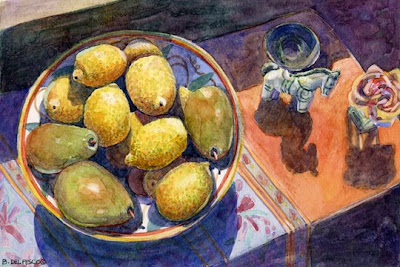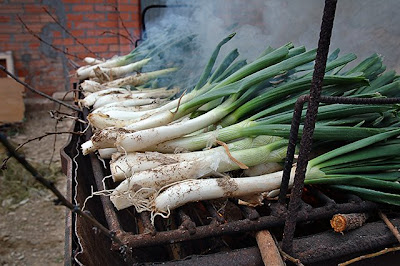I am reposting this review and comparison from early 2005 because many of the people dropping by now weren't coming by then. Recently I pulled out both books for a similar comparison to that below and again was struck by their complementary nature. Anyone who is really serious about cooking already knows all about On Food and Cooking. This classic work was the first to look at how real science relates to cooking. It has influenced major chefs, the Culinary Institute of America (CIA), and plain old regular cooks like me. I remember how amazed I was when reading about food properties and realizing how I could use some of the principles when I cooked.
When I heard about the new 25th anniversary edition coming out I could not wait to get my hands on it. Of course, I haven't read the entire book yet but I must say that this is much more approachable and spends more time relating the science directly to the cooking. There is quite a bit more information about various subjects than in the previous edition. Just one example, McGee fleshes out the cookie section with a lot more information. The original contained one short paragraph explaining that cookies are much higher in sugar and fat than bread dough. The revised version has several pages about cookies that cover ingredients and textures, making and keeping cookies by variety, and a chart of ingredients and typical proportions of various cookies.
I read an interview with Harold McGee where he said that he had to drop some of the information about human physiology and additives (if I remember correctly). That was disappointing but I understood how a lot of that info might already be incorporated into other sections of the book. And then came that fateful dinner last week when I served
red beans and rice. I mentioned that red beans and rice combined to make a complete protein and Rose told me that I was wrong. Her Honors Biology teacher had just finished teaching them that the body manufactures protein itself and, according to Rose's way of thinking, this made any need for combined protein unnecessary. Never mind that this was not a really logical argument. Hell hath no certainty like a 14-year-old in Honors Biology. The only thing that would convince her was written information. No problem. I pulled out the new
On Food and Cooking ... but couldn't find anything on complete or incomplete proteins. It didn't matter if I looked under protein or legumes, there was nothing about combined proteins, and this was a fact that had been drilled into me since I don't know when, using examples like beans and tortillas.
So, with Tom double checking the new book, I pulled out the
1984 book. The third paragraph under Grains, Legumes and Nuts read:
Seeds are much more convenient than meat, milk, eggs, and other sources of protein that are quick to spoil. But they have an important drawback: unlike meat, milk, or eggs, any particular kind of seed is usually an incomplete protein source for animals, because it is deficient in one or more of the essential amino acids. Over the millennia, however, widely separated cultures have learned to combine different seeds in their diet so as to balance their protein intake. For example, the Asian diet of rice and soybeans and the Central American diet of corn and common beans have been traditional for many centuries. Today we now that the cereals are deficient mainly in lysine, the legumes in sulfur-containing amino acids; but when the two foods are blended together, these deficiencies are canceled out.
This was pretty good but now Rose was talking about how we have most of the amino acids we need; that we don't really need any extras or, if so, only a few. And, if our bodies already made protein then why did we need more? She needed more facts or we were going to have this argument all night long. So I turned to the section about Protein and in the third and 4th paragraphs found this:
We need protein in our food because it constitutes the basic machinery of all life. Take away the water in our bodies and most of what is left in our muscles, organs, blood, cells, skin, nails, hair, even our teeth and bones, is protein. The enzymes that build up and break down other molecules, disease-fighting antibodies, oxygen-carrying hemoglobin, certain hormones like insulin: all these chemicals whose incessant activity keeps us going, are proteins. they are continually being used up or worn away, and protein from our diet is used to replace them, or, in growing children, to build them up. Like fats and carbohydrates, proteins can be burned for energy, but this happens only when supplies of these preferred fuels run low. Excess protein in an otherwise adequate diet will be converted to fat, but as one nutritionist has put it, this is analogous to buying fine furniture and then using it as firewood.
Twenty amino acids go to make up all human proteins. Of these, the adult needs a dietary supplement of 8, the growing child 9 or 10. Our cells can synthesize the others, and from them the necessary proteins. Dietary protein is classified according to its provision of essential amino acids. Complete proteins include enough of them to allow complete normal bodily growth and function. All animal foods -- meats, eggs, milk products -- are complete protein sources, because all animals have the same basic biochemical machinery. Plants are organized in a very different way, however, and so plant proteins are generally incomplete. there are some exceptions to these rules, and human manipulation can make a difference as well. For example, wheat germ and soybean proteins are nearly complete, while gelatin, which is extracted from animal skin and bone, and zein, the major corn protein, are so incomplete that they cannot sustain life at all. Between these extremes, whole grains, beans, and nuts are barely adequate. Each typically lacks sufficient quantities of a couple of amino acids, and these deficiencies lower the total amount of usable protein. If a food contains more total protein than we need, but has only 50% of the necessary amount of one essential amino acid, then it can provide only 50% of our overall requirement ...
I have since looked all over the 2004 edition thinking that being under the gun to produce facts made me miss the pertinent info elsewhere but it is nowhere to be found. Comparing the sections on Legumes and Proteins between the two books made me realize that they actually are complementary but written with very different viewpoints. The first book is all about the science. Some conclusions are applied to food but it always comes back to scientific information as the heart of the material. The second book is first and foremost about applying science to cooking. This may sound like a slight difference and there probably is a better way to describe it but it makes a world of difference when reading the book. Therefore the new Protein section is all about what happens to foods high in protein when heat is applied, or acid is added, etc.
This does not make the new book either superior or inferior. However, it is important to understand that it is a
different book. Whether you use it simply depends on what sort of information you need and how you plan to apply it. I am still thoroughly enjoying McGee's new version and am sure it will all come in handy with practical cooking situations. However, when it comes to Rose and Honors Biology ... only the old version will suffice. In my view, McGee has produced a two-volume set and I plan on using both often.





